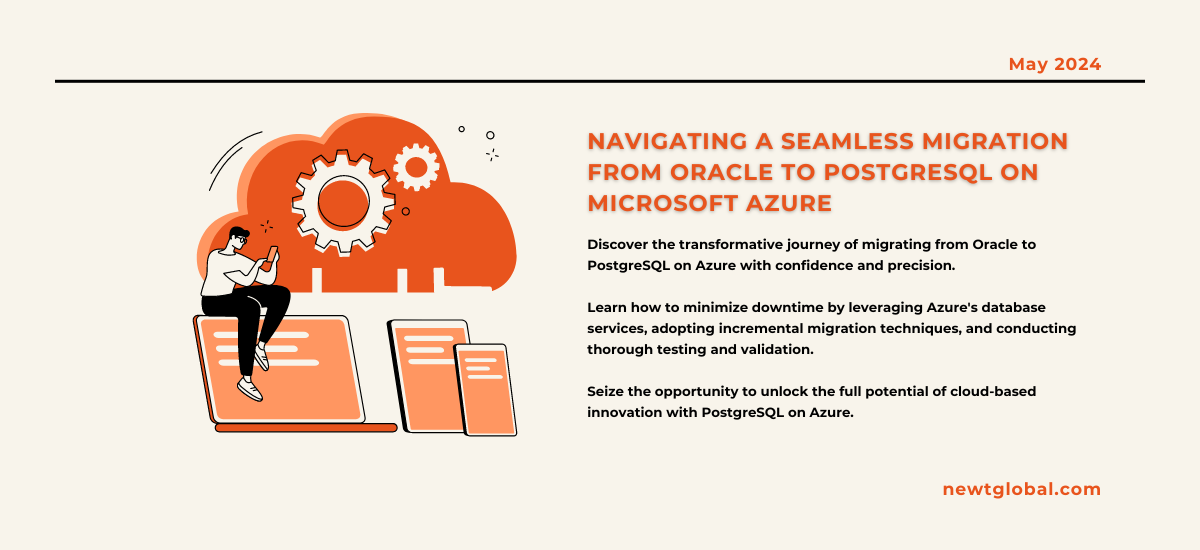
Are you seeking ways to minimize downtime and ensure a seamless transition during this Oracle to PostgreSQL migration on Microsoft Azure? If so, read on to discover how you can navigate the complexities of database migration with confidence and precision.
In today’s dynamic business landscape, the migration to cloud-based solutions has emerged as a strategic necessity for organizations seeking to augment agility, scalability, and cost-efficiency. As an Oracle user contemplating this shift, you’re undoubtedly cognizant of the challenges inherent in mitigating downtime during the migration process. From navigating data compatibility concerns to managing application dependencies, transitioning to PostgreSQL on Azure presents an array of obstacles that require meticulous planning and execution.
But fear not! By leveraging cutting-edge technologies and best practices, you can optimize the migration process and facilitate a seamless transition. Microsoft Azure, with its comprehensive suite of database services, provides a tailored solution for Oracle users considering a migration to PostgreSQL. With features such as high availability, automatic failover, and data encryption, Azure empowers you to ensure uninterrupted operations while transitioning to a cloud-native environment.
Ready to embark on your migration journey? Let’s delve into the complexities of database migration, explore Azure’s database services, and equip you with the tools and techniques necessary to minimize downtime and ensure a successful transition to PostgreSQL on Microsoft Azure.
Understanding the Challenge: Minimizing Downtime in Database Migration
Downtime represents a significant concern during database migrations, particularly within critical business operations. An essential consideration in this context involves data compatibility issues. Oracle and PostgreSQL boast distinct syntaxes and features, necessitating meticulous attention to ensure a seamless transition. Understanding how data will be translated and migrated between these two systems is imperative for minimizing disruption.
Additionally, performance bottlenecks present another formidable challenge. PostgreSQL may demand distinct optimization strategies compared to Oracle, necessitating a comprehensive grasp of these disparities to uphold or enhance performance post-migration.
Furthermore, the presence of application dependencies can compound migration complexities. Applications reliant on specific Oracle features or configurations may necessitate adjustments or even complete rewrites to seamlessly integrate with PostgreSQL. Early identification and resolution of these dependencies are pivotal in mitigating potential disruptions to the migration process.
Strategies for Minimizing Downtime:
Comprehensive Planning and Assessment
Comprehensive planning and assessment are essential pillars for the successful execution of the migration process. Organizations must commence this phase by conducting a thorough analysis of their Oracle databases, encompassing aspects such as schema structure, data dependencies, and performance prerequisites. This comprehensive assessment forms the foundation for identifying potential risks and developing a meticulously detailed migration plan, finely tailored to the organization’s unique requirements and objectives.
In conjunction with this, organizations must consider critical factors such as data security, compliance requirements, and robust disaster recovery strategies. Addressing these pivotal aspects at the outset of the planning phase enables businesses to proactively mitigate potential disruptions and facilitate a seamless transition to PostgreSQL on Azure.
Leveraging Azure Database Services
Microsoft Azure offers a range of database services designed to simplify the migration process and minimize downtime. Azure Database for PostgreSQL provides a fully managed, enterprise-ready PostgreSQL database service, enabling organizations to migrate their Oracle databases to the cloud with minimal disruption.
By leveraging Azure’s built-in features such as high availability, automatic failover, and data encryption, organizations can ensure continuous operations throughout the migration process. Additionally, Azure’s scalability and flexibility make it easy to adjust resources as needed, ensuring optimal performance during and after the migration.
Data Replication and Synchronization
Data replication and synchronization stand as indispensable elements in the effort to minimize downtime during database migrations. Azure Database Migration Service (DMS) serves as a pivotal tool, empowering organizations to replicate data from their Oracle databases to PostgreSQL on Azure with minimal disruption to operations.
DMS operates by continuously synchronizing data between the source and target databases, thereby ensuring data consistency and integrity throughout the migration process. By facilitating near real-time data replication, organizations can effectively minimize downtime and facilitate a seamless transition to PostgreSQL on Azure.
Incremental Migration Techniques
Incremental migration techniques present a strategic approach to reducing downtime. Rather than executing a mass migration of all data in a single batch, organizations can adopt incremental migration techniques. By breaking down the migration process into smaller, more manageable tasks, organizations can prioritize critical data sets and mitigate the impact on operations.
Furthermore, incremental migration techniques offer the advantage of enabling organizations to identify and address potential issues more effectively. By migrating data in smaller increments, organizations can meticulously test and validate each stage of the migration process, thereby ensuring a smooth transition from Oracle to PostgreSQL on Azure.
Validating Success: Thorough Testing and Validation
Before finalizing the migration, thorough testing and validation are essential to identify and address potential issues. Perform performance testing, compatibility testing, and end-to-end validation to ensure the functionality of applications and services post-migration. By rigorously testing each stage of the migration process, you can minimize downtime and ensure a smooth transition to PostgreSQL on Azure.
Conclusion: Seize the Opportunity for Seamless Migration
In conclusion, the migration from Oracle to PostgreSQL on Microsoft Azure presents a transformative opportunity for organizations seeking to embrace cloud-native solutions. By leveraging Azure’s database services, adopting incremental migration techniques, and conducting thorough testing and validation, you can minimize downtime and ensure a seamless transition to PostgreSQL on Azure.
Are you ready to embark on your migration journey? Take action today and unlock the full potential of cloud-based innovation with PostgreSQL on Microsoft Azure.
Visit newtglobal.com to learn more about our comprehensive cloud migration services and how we can help you seamlessly transition from Oracle to PostgreSQL on Microsoft Azure. For further inquiries or to discuss your specific migration needs, please reach out to us at marketing@newtglobalcorp.com.
